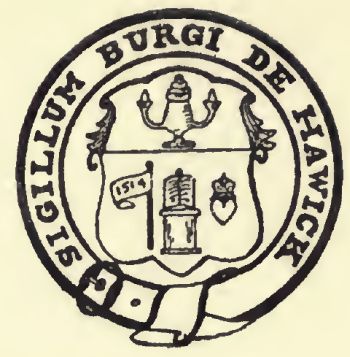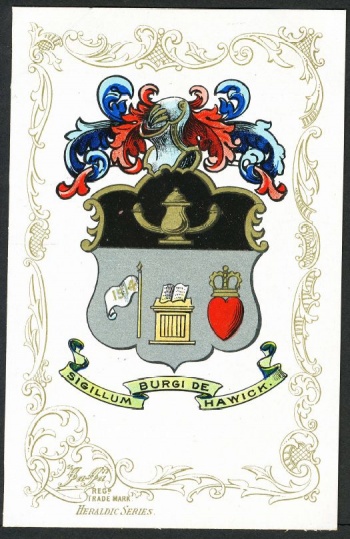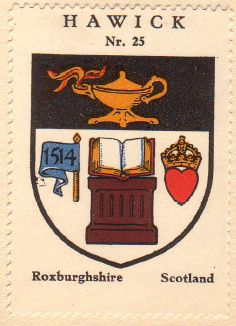Hawick
| Heraldry of the World |
| British heraldry portal Civic heraldry of the United Kingdom |
|
HAWICK
Incorporated into : 1975 Roxburgh (1996 Scottish Borders)
Burgh
Official blazon
Argent, an altar, thereon an open Bible, both Proper, between on the dexter, a flag Azure charged with a saltire Or and inscribed with the date 1514 Gold, waving towards the dexter from a staff of the Last, and on the sinister a man's heart Gules ensigned with an imperial crown Gold; on a chief Sable, a lamp with two branches also Gold, enflamed and irradiated Proper.
Under the Shield which is ensigned of a Burghal coronet is placed in an Escrol this Motto "Tyr-ibus Ye Tyr Ye Odin".
Origin/meaning
The arms were officially granted on June 14, 1929 without the motto, and again on August 20, 1957.
The arms reflect the device on the Burgh seal in use in 1892. The altar and the Bible stand for the parish church, dedicated in 1214, and the Douglas crowned heart is for Sir James Douglas of Drumlanrig.
The blue flag with its golden saltire and date of 1514 recalls the defeat, at nearby Hornshole, of a body of English soldiers connected with Hexham Abbey, some time after the Battle of Flodden (1513). This English standard, or a replica of it - a gold saltire on a blue field (for Hexham Abbey)- is said to have been carried in every subsequent Common Riding Ceremony at Hawick.
The lamp in the chief is a reminder of the condition in the first Charter that a lamp should be kept burning before the great altar in the parish church "in time of High Mass and evening prayers on all Holy Days throughout the year, in honor of our Blessed Lord and Saviour Jesus Christ, for the souls of the Barons of Hawick, founders of the said lamp and their successors".
The motto, which is said to have been an invocation to Thor and Odin, comes from the refrain to the Hawick Common Riding Song written by James Hogg, the Ettrick Shepherd, "to commemorate the laurels gained by the men and youth of Hawick at and after Flodden".
When the arms were granted in 1929, the motto, which had been long in use, was for some reason overlooked, but the omission was put right in 1957. At the same time, an error was discovered and corrected in the drawing in the Lyon Register where the Hawick banner had been given a silver saltire instead of a gold one.
| Seal of the burgh as used in the 1890s |
|
| The arms as used on a JaJa postcard +/- 1905 |
The arms in the Coffee Hag albums +/- 1925 |
Community Council
Official blazon
Argent, an altar, thereon an open Bible, both Proper, between on the dexter, a flag Azure charged with a saltire Or and inscribed with the date 1514 Gold, waving towards the dexter from a staff of the Last, and on the sinister a man's heart Gules ensigned with an imperial crown Gold; on a chief Sable, a lamp with two branches also Gold, enflamed and irradiated Proper.
Above the Shield is placed a coronet appropriate to a statutory Community Council, videlicet:- a circlet richly chased from which are issuant four thistle leaves (one and two halves visible) and four pine cones (two visible) Or; and in an Escrol below the same this Motto "Tyr-ibus Ye Tyr Ye Odin".
Origin/meaning
The arms were granted on October 23, 1978.
The arms are based on the old burgh arms, but with the crown of a community council.
Contact and Support
Partners:
Your logo here ?
Contact us
© since 1995, Heraldry of the World, Ralf Hartemink 
Index of the site
Literature : Urquhart, 1974, 1979, 2001
















